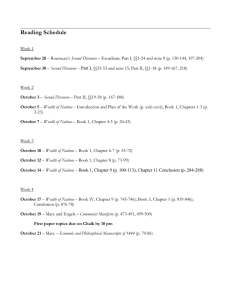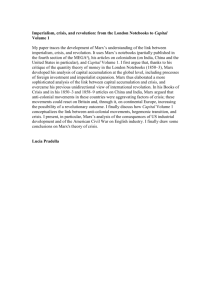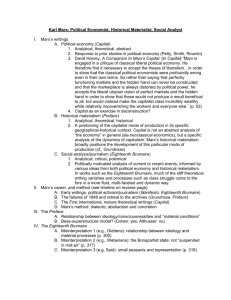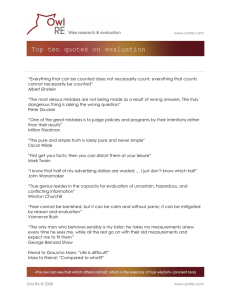Grundrisse Marx Without Guardrails: Geographies of the Geoff Mann
advertisement
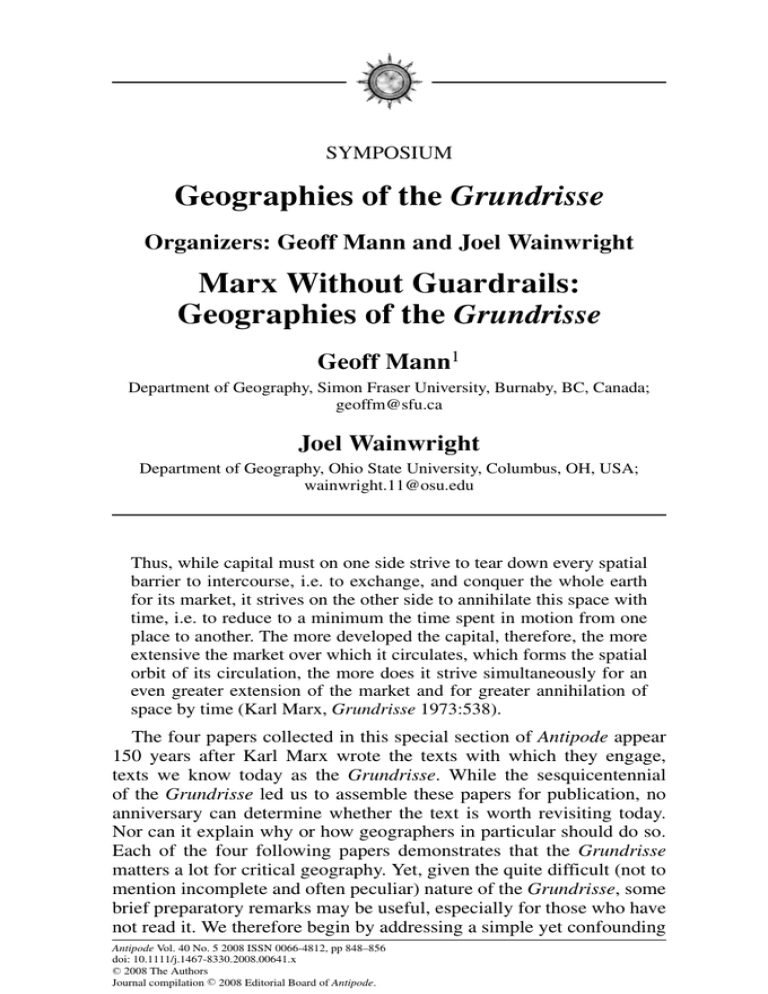
SYMPOSIUM Geographies of the Grundrisse Organizers: Geoff Mann and Joel Wainwright Marx Without Guardrails: Geographies of the Grundrisse Geoff Mann1 Department of Geography, Simon Fraser University, Burnaby, BC, Canada; geoffm@sfu.ca Joel Wainwright Department of Geography, Ohio State University, Columbus, OH, USA; wainwright.11@osu.edu Thus, while capital must on one side strive to tear down every spatial barrier to intercourse, i.e. to exchange, and conquer the whole earth for its market, it strives on the other side to annihilate this space with time, i.e. to reduce to a minimum the time spent in motion from one place to another. The more developed the capital, therefore, the more extensive the market over which it circulates, which forms the spatial orbit of its circulation, the more does it strive simultaneously for an even greater extension of the market and for greater annihilation of space by time (Karl Marx, Grundrisse 1973:538). The four papers collected in this special section of Antipode appear 150 years after Karl Marx wrote the texts with which they engage, texts we know today as the Grundrisse. While the sesquicentennial of the Grundrisse led us to assemble these papers for publication, no anniversary can determine whether the text is worth revisiting today. Nor can it explain why or how geographers in particular should do so. Each of the four following papers demonstrates that the Grundrisse matters a lot for critical geography. Yet, given the quite difficult (not to mention incomplete and often peculiar) nature of the Grundrisse, some brief preparatory remarks may be useful, especially for those who have not read it. We therefore begin by addressing a simple yet confounding Antipode Vol. 40 No. 5 2008 ISSN 0066-4812, pp 848–856 doi: 10.1111/j.1467-8330.2008.00641.x C 2008 The Authors C 2008 Editorial Board of Antipode. Journal compilation Marx Without Guardrails 849 question—what exactly is the Grundrisse?—before turning to some of the theoretical issues the text raises. We conclude by introducing the four papers in this special section, to position the Grundrisse in relation to Marxist geography. What is the Grundrisse? What we know today as the Grundrisse contains a selection of notebooks Marx wrote in the 1850 s. The first edition, published in Moscow in 1939–1941 under the title Grundrisse zur Kritik der politischen Ökonomie (Rohentwurf) [Outlines for a Critique of Political Economy (Rough Draft)], from which we obtain the short title Grundrisse, collected together all of Marx’s extant notebooks on political economy written between 1850 and 1859 (Lallier 1989:xv).2 The German edition of 1953, however, and its English translations, contain only eight notebooks, those Marx wrote late into the London nights between August 1857 and June 1858, while he worked during the day as a correspondent for the New York Daily Tribune.3 They include the famous Notebook M (also known as the “1857 Introduction”), arguably Marx’s most comprehensive comment on method, and seven others, numbered 1 through 7. As published, Notebook M stands alone, Notebooks 1 and 2 constitute the “Chapter on Money”, Notebooks 3–7 the “Chapter on Capital”. Neither “Chapter” is a chapter in the sense of Capital; each runs to hundreds of pages and sprawls through many themes and subsections. The title is another source of confusion. The first publisher of the notebooks, the Institute for Marxism–Leninism, drew the title from Marx’s description of the project in a letter to Engels of December 1857, a letter that provides a sense of Marx’s intensity at this time, an intensity brought on by his sense of impending social transformation. Marx wrote that he desperately wished to complete the Grundrisse, or outlines, of his economic study “before the deluge” (cited in Oakley 1983:52).4 The “deluge” to which Marx refers is the international fallout of the Panic of 1857, the result of a banking crisis triggered in the US in the late summer (24 August). With the collapse of one New York institution, the response of the region’s financial community was to limit or stop almost all financial transactions. In turn, individual and institutional depositors, including a great deal of European (especially British) capital, panicked, precipitating a run on the banks that spread across the United States. On 14 October, later remembered as “Suspension Day”, banks across New York and New England suspended all transactions in an attempt to slow hoarding, the flight back to money as precious metal, what Marx called a return to “barbaric conditions” (1973:230). Marx started writing the “Chapter on Money” as the crisis crossed the Atlantic in late 1857, as British manufacturing went into a free C 2008 The Authors C 2008 Editorial Board of Antipode. Journal compilation 850 Antipode fall and unemployment skyrocketed. For him, in a manner not unlike the monetary crisis in Louis Bonaparte’s France the previous year, the Panic of 1857 made manifest the inevitable crises of capital as value-in-motion: in the period leading up to the collapse, capital, in its relentless effort to expand, had exacerbated the inherent tendency to overcapacity in the economy. The resulting disproportionalities between production and circulation, which up to a point had been maintained by a constant flow of speculative investment in fixed capital, reached a level of instability at which the bubble burst: circulation stopped and capital ceased to function as process.5 The crisis seemed to portend a revolutionary opening and filled Marx with hope. He wrote to Engels: “the stock exchange is the only place where my present dullness turns into elasticity and bouncing” (cited in Rosdolsky 1977:7). The Grundrisse emerged at the time and in the manner it did because its formulation was so urgent in the face of such opportunity. Just as the economic tempest drove him to frantically work out his theory, the political economy which precipitated it was his object of analysis. The resulting notebooks may be read as extended reflections on the relations between money-as-commodity and moneyas-capital, the law of equivalence, disproportionality, and the meaning of the categories of money, capital, and value. But then there are many ways to read the Grundrisse. Reading the Grundrisse In contrast to Capital, the Grundrisse is Marx without guardrails. It does not unfold through neatly delineated sections and chapters; it is frequently repetitive and often obtuse. So what we have come to see as the “outline” or “ground-plan” of Capital is not carefully outlined, grounded, or planned. In Gayatri Spivak’s words the Grundrisse is “a creative digest of Marx’s readings” (1995:73) to which we may add that it is a digest without table of contents, executive summary, or index.6 Yet the text remains deeply compelling for at least two reasons. On the one hand we find an astonishing range of analysis of a broad range of questions. Some of the topics Marx considers in the Grundrisse are never again substantively addressed; his discussion of pre-capitalist economic formations (on which see the papers by Wainwright and Sayre), for instance, goes farther than any subsequent text. On the other hand, the Grundrisse’s treatment of its diverse topoi is compelling because it provides perhaps the clearest window available through which to observe Marx at work—the ways he worked through ideas, the relentless energy with which he approached the problem of political economy. As such, the legacy of the notebooks is enormously complicated and exciting, and has attracted so much attention, at least partly because they comprise the point of production for some of Marx’s most important theoretical C 2008 The Authors C 2008 Editorial Board of Antipode. Journal compilation Marx Without Guardrails 851 developments regarding concepts we now understand as central to his theoretical legacy, including money, labor, and capital. This is not to say that these categories emerge from the text as final products; rather, one finds in the Grundrisse their early, more plastic formulations. Such conceptual unfolding, in combination with the relative lack of structure, narrative, and formality, allows the Grundrisse to serve, for many, as a path to a more open Marxism. It is also true that this plasticity and openness make the text an object of heated exegetical battles among Marxists. These debates have revolved around several issues, the most contentious being the problems the notebooks pose for an ostensibly “scientific” Marxism or rigorous Marxist social science. It is not that Marx does not pursue the concerns of the Grundrisse in the exhaustive, dialectical manner for which he is known. He did. The challenge derives from the lack of theoretical closure. The text crackles with categorical instability. This raises several interpretive questions that remain important for Marxist theory and practice. Let us consider two. First, there is the question of the Grundrisse’s relation to Capital. Are they fundamentally separate and different works? Or is Grundrisse merely the “rough draft”, a flawed first attempt, as the first editors’ title suggests? If bits are missing from Capital, does that mean that Marx disavowed his earlier analysis? If so, how does that matter for Marxist thinking? We know that Marx never intended the Grundrisse for publication. Given the preponderance of Capital for Marxists (ourselves included), these are points of longstanding debate. The intractability of these questions is compounded by the impossibility of reading the Grundrisse as an independent work today. It is probably a rare reader who comes to Marx first through the notebooks; for those of us who have read Capital beforehand, it is hard not to read the Grundrisse retrospectively, through the lens of the later work, as if it were itself a product of what followed. Still, holding the Grundrisse against the background of Capital has sometimes enabled exciting and original readings. Some even discover in the Grundrisse a Marx more original, more pure, even more important than the author of Capital. For instance, in his Paris lectures on the Grundrisse, published as Marx Beyond Marx (1991), Antonio Negri argues that the Grundrisse is the crux of Marx—not so much a turning point, which implies a discovery that improves the process, but in fact the highest expression of Marx’s originality. After writing the Grundrisse, Negri says, Marx became too gripped by his accidental reading of Hegel’s Logic, and his earlier emphasis on a kind of absolutely productive, subjective labor that stands fundamentally outside or apart from capital was deflated, effectively lost. Through a redemptive reading of the Grundrisse, Negri extracts its radically open, un-Hegelian quality and its creative approach to subjectivity and labor. C 2008 The Authors C 2008 Editorial Board of Antipode. Journal compilation 852 Antipode In contrast, Kojin Karatani (2003:5) claims that the “Marxian turn”, the moment of Marx’s essential insight, “occurred in his middle career, in the shift from Grundrisse . . . to Capital: it was the introduction of the theory of ‘value form’”, a shift that Karatani attributes to Marx’s encounter with Samuel Bailey’s critique of Ricardo.7 In other words, Marx’s radical turn came only “after he finished writing Grundrisse”. Both Negri and Karatani agree that Marx’s central contribution was to elaborate the value form, to show that value is produced by labor, objectified, and circulated in a way that deepens the division between labor and capital (which both theorists relate to Marx’s theory of the subject). Without elaborating on this debate,8 the key point is that the question of the status of the Grundrisse within Marx’s oeuvre—mere draft of Capital or independent creative workshop?—cannot ultimately be separated from more substantive debates over Marx’s basic economic concepts. Hence the need for coming to terms with the text. This brings us to a second question raised by what most readers (pace Negri) see as the much more explicit influence of Hegel’s thought on the Grundrisse in comparison to Capital—indeed, the papers included here by Gidwani and Mann are partly focused on the centrality of Hegel to an understanding of the notebooks. The Grundrisse’s rise to prominence in recent decades owes much to the attention it has received from Marxists for whom Hegel, and Hegel’s influence on Marx, is important. The best known of this camp—Lenin, Trotsky, Lukács and Gramsci—all wrote before the Grundrisse was published, yet their thinking has secured the recognition of Hegel’s relevance to our understanding of Marx (a debt recognized by many otherwise different contemporary Marxists, such as David Harvey and Fredric Jameson). Not surprisingly, with the important exceptions of Negri and Lucio Colletti (1973 [1969], 1975), the Grundrisse receives less textual attention from non- or anti-Hegelian Marxists of various stripes. This is especially true of the “scientific” Marxists for whom Capital reigns supreme, and who for a time did so much to shape post-World War II Marxism. Louis Althusser is the best known of this group, which also includes Galvano Della Volpe, Colletti, and Jon Elster (as well as some of Elster’s fellow “analytical Marxists”, most of whom are now definitively ex-Marxists). This group essentially agrees on only one point: the need to purge Marxism of Hegel’s purported idealism and mysticism. Thus the Grundrisse is often left out of anti-Hegelian accounts of Marx.9 Yet, as Mann demonstrates in his paper, reading the Grundrisse makes that purge difficult, because the Hegelianism of the Grundrisse is fundamental, not in the least idealist, and essential to the text’s capacity to found a Marxism independent of the scientificity of Capital. To confront the Grundrisse, then, with its clues to the meaning of Hegel for Marx, is a theoretical challenge with far-reaching implications, C 2008 The Authors C 2008 Editorial Board of Antipode. Journal compilation Marx Without Guardrails 853 for it exposes an anti-teleological Marx obsessed with historical processes, yet deeply scornful of History (see the papers by Gidwani, Wainwright and Mann). In the notebooks we find the concerns of Capital exposed much more aggressively to the flames of the dialectic than in the latter work. Gayatri Spivak writes of the Grundrisse: “[l]ifting the lid, Marx discovers that the pot of the economic is forever on the boil” (Spivak 1985:74). We might say the same of the pot that geographers call the world. Geographies of the Grundrisse While it is by no means easy to state what Marx’s theory is, at least it is possible to clarify what it is not. It is not a speculative philosophy of history. Professedly a deconstruction of universal History, it opens the way to a history that promises no salvation, offers no guarantee to redress injustice—not even the faintest possibility. A profane history emerges whose trajectory is unsettled, in that it is determined conjointly by struggle and necessity. Hence there is no question of founding a new philosophy of some unidirectional history. What we have, instead, is a new way of writing history, whose alphabet is suggested by the Grundrisse (Bensaı̈d 2002 [1995]:2–3). Bensaı̈d’s comments on the historicality of Marx’s thought provide us with a powerful language to introduce the geographies of the Grundrisse. The notebooks certainly do not provide a philosophy of geography, but they open a way to a geography without salvation, without guarantees; it is unsettling, profane geography. Let us explain. Antipode readers are familiar, particularly through the work of David Harvey, with the ways Marx’s analysis of capitalism in Capital opens a radical reinterpretation of the world’s geographies (on Harvey and the Grundrisse, see the paper by Sayre).10 In different respects, the four papers collected in this section argue that the Grundrisse has still more to offer geographers. So too do they suggest that the way we read the Grundrisse will shape how Marx matters for us geographers today. Part of the fecundity of the text for our geographical imagination stems from what we could consider the Grundrisse’s setting. Like Capital, the Grundrisse was written in Victorian London and traces of that imperial, urban environment appear in the text. Yet there is an important distance in the feel of this setting. Capital often reads like an analysis of industrial, urban capitalism such as could only have been found in London at the time of its writing; the first volume makes reference to its workshops and state, labor laws, the social history of the British enclosures, and in the last chapter, British colonialism (on which see the paper by Wainwright). Of course, Capital is about capitalism, not British capitalism. Nevertheless, few readers could mistake the book’s setting, and we are perhaps not the only Marxists who have difficulty C 2008 The Authors C 2008 Editorial Board of Antipode. Journal compilation 854 Antipode imagining what Capital might look like had it been written in, say, Paris, or, for that matter, Beijing. Here the difference with the Grundrisse is stark and fruitful, we believe. “Capital by its nature drives beyond every spatial barrier”, Marx wrote (1973 [1953]:524), and the text too explodes spatial barriers. Indeed, the “setting” is so undefined that is can only be called unsettled; the Grundrisse produces a palpable sense of indefinite, even volcanic, geography: more than Capital, the Grundrisse describes capitalism and the world, in its world-becoming and its becoming-worldly. The Grundrisse is thus volcanic for its concepts emerge in a world of contradictory and still-unfolding spaces. Whereas a reader may (perhaps mis-)read Capital as a book about England’s capitalist society and its eventual overthrow by the British proletariat, there can be no mistaking Grundrisse as anything other than a text of geography without salvation, set in a world without guarantees. Something of this luminescent fluidity is captured, we hope, in each of the four papers collected here. The paper by Vinay Gidwani that introduces our quartet begins with the Grundrisse’s almost breathless tone and the restless moment in which Marx was writing. Yet the text’s tumultuous energy is not merely a product of its times, but also its analytical approach. As Gidwani argues, for the Marx of the Grundrisse, there are two Hegels: one to be embraced, another to be wary of; a Hegel of contradiction and confrontation, and a Hegel of identity and closure. Separating the two is perhaps impossible. Part of the Grundrisse’s complex energy arises in Marx’s struggle to do so. Reading this tension in the Grundrisse alongside Spivak’s ‘Can the subaltern speak?’, Gidwani proposes that the Grundrisse may be seen as postcolonial Marxism avant la lettre. This theme is also advanced in the paper by Joel Wainwright, which traces the problematic of uneven development and colonialism from Grundrisse to Capital. By examining the shifts in Marx’s treatment of pre-capitalist social relations, the development of capitalism, and colonialism between these two texts—focusing in particular on Marx’s writings on Edward Gibbon Wakefield—Wainwright argues that Marx’s economic analysis of capitalism, culminating in Capital, hinges upon his discovery of the interrelation of uneven development and imperialism. The third contribution, by Nathan Sayre, considers the impact of the translation of the Grundrisse on Anglo-American geography and anthropology. Sayre argues that the Grundrisse has been vastly more important to the development of the two disciplines than might be immediately apparent. He suggests that the Grundrisse made possible not only some of David Harvey’s contributions, but also helped to end the heated formalist-substantivist debate in economic anthropology. And, more broadly, it has contributed to the ability of both geographers and C 2008 The Authors C 2008 Editorial Board of Antipode. Journal compilation Marx Without Guardrails 855 anthropologists to understand the ongoing processes of financialization so influential in the contemporary world. The last article in the section, by Geoff Mann, reads the Grundrisse as a call to revive Marx’s analysis of historical necessity. Digging into the notebooks by way of the Hegelian concepts that run through it, Mann argues that a non-determinist, historicized necessity is not only essential to an understanding of Marx’s work, but proves central to critical historical–geographical explanation more broadly. Reading the passages on “the annihilation of space by time” against their Hegelian ground, he tries to uncover the seeds of what might be called a communist geography. Endnotes 1 The author-editors collaborated evenly on this introduction and the issue; our names are listed alphabetically. 2 These include 24 notebooks from 1850 to 1853 on a variety of topics; annotated excerpts from Ricardo’s Principles from 1851; a manuscript on foreign exchange from 1854–1855; a fragment on Bastiat and Carey from 1857; a “new theory of profits” written around the period of the eight principal notebooks; and the so-called “Urtext”, written in the summer of 1858, which is often seen as an intermediary between the “Chapter on money” and the Contribution to the Critique of Political Economy that appeared in 1859. For the “Urtext”, see Collected Works, vol 29 (1986–1987:430–507). The four papers that follow this introductory essay engage only those notebooks published in the English and German editions. 3 There are two English translations of these notebooks. The more commonly used is that of Martin Nicolaus, which appeared with an excellent introduction in 1973 (New York: Vintage). The second, and some say better (e. g. Arthur 2006) translation, is by Ernst Wangermann (Marx and Engels 1986) and Victor Schnittke (1987). It can be found in volumes 28 and 29 in the Collected Works, with a preface by Tatyana Vasilyeva. 4 The following month, he wrote again to Engels: “I’m working colossally—usually until 4 a. m. My task is twofold; 1) to work out the fundamentals of the economics . . . 2) the present crisis” (cited in Rosdolsky 1977:8). 5 To anyone observing the current financial meltdown—another crisis of capital-asprocess in which the banking system does not perform its role as the mechanism of circulation—may sound familiar. As for economic primitivism: as we wrote this introduction, the nominal price of gold surpassed $1000/oz for the first time. 6 Our reference to Spivak comes from a passage where she attributes Marx’s discovery in the Grundrisse in these terms: “A Contribution to the Critique of Political Economy, like the ‘Economic and philosophical manuscripts’ and the Grundrisse, is in large part a creative digest of Marx’s readings. It is of course in the notebooks of the Grundrisse, comprising notes taken in 1857–58, that the notion of capital being engendered in the human difference between making and needing is discovered. Because this is not yet there in Contribution (published the following year, while the researches of the Grundrisse are fermenting), there is much greater emphasis on the so-called ‘alienation of use value’” [Contribution 491] (1995:73). 7 See section 5.2 of Transcritique (2003:193–196); for another elaboration, see Furner (2007). 8 Briefly, Wainwright thinks that Karatani has it right, and Mann departs from both Karatani and Negri—as readers will find in his paper, he argues that the very greatness of the Grundrisse lies in its intensely Hegelian qualities. C 2008 The Authors C 2008 Editorial Board of Antipode. Journal compilation 856 Antipode 9 For instance, in the whole of the English edition of Althusser’s and Étienne Balibar’s enormously influential Reading Capital, the Grundrisse is only mentioned once, by Balibar (1970 [1968]:201). As Althusser (1971:103) later wrote in his preface to the French edition of Capital, “it is to be predicted that, along with the German Ideology, the Grundrisse will provide all the dubious quotations needed by idealist versions of Marxist theory”. The Hegelianism of the Grundrisse was emphasized for English readers in particular because the most widely circulated English edition was translated and introducted by Martin Nicolaus, a Marxist for whom Hegel is extremely significant. 10 Just as we cannot read the Grundrisse today except through Capital, we can hardly approach the geographical dimensions of these texts without interpreting them in light of David Harvey’s work. References Althusser L (1971) Lenin and Philosophy and Other Essays. Translated by B Brewster. New York: Monthly Review Press Althusser L and Balibar É (1970 [1968]) Reading Capital. Translated by B Brewster. London: New Left Books Arthur C J (2006) A Guide to Marx’s Grundrisse in English. http://www.psa.ac.uk/ spgrp/marxism/online/arthur.pdf Accessed 12 March 2008 Bensaı̈d D (2002 [1995]) Marx for Our Times: Adventures and Misadventures of a Critique. Translated by G Elliot. New York: Verso Colletti L (1973 [1969]) Marxism and Hegel. Translated by L Garner. London: New Left Books Colletti L (1975) Introduction. In K Marx Early Writings (pp 7–56). Translated by R Livingstone and G Benton. London: Penguin Furner J (2007) Marx’s critique of Samuel Bailey. Historical Materialism 12(2):89–110 Lallier, AG (1989) The Economics of Marx’s Grundrisse: An Annotated Summary. London: Macmillan Karatani K (2003) Transcritique: On Kant and Marx. Boston: MIT Marx K (1973 [1953]) Grundrisse. Translated by M Nicolaus. New York: Vintage Marx K (1974 [1953]) Grundrisse der Kritik der politischen Ökonomie. Frankfurt: Verlag Marx K and Engels F (1986–1987) Collected Works. New York: International Publishers Negri A (1991 [1979]) Marx Beyond Marx: Lessons on the Grundrisse. Translated by H Cleaver, M Ryan and M Viano. Brooklyn: Autonomedia Oakley A (1983) The Making of Marx’s Critical Theory: A Bibliographic Analysis. London: Routledge and Kegan Paul Rosdolsky R (1977) The Making of Marx’s “Capital”. Translated by P Burgess. London: Pluto Press Spivak GC (1985) Scattered speculations on the question of value. Diacritics 15(4):73– 93 Spivak GC (1995) Ghostwriting. Diacritics 25(2):64–84 C 2008 The Authors C 2008 Editorial Board of Antipode. Journal compilation
